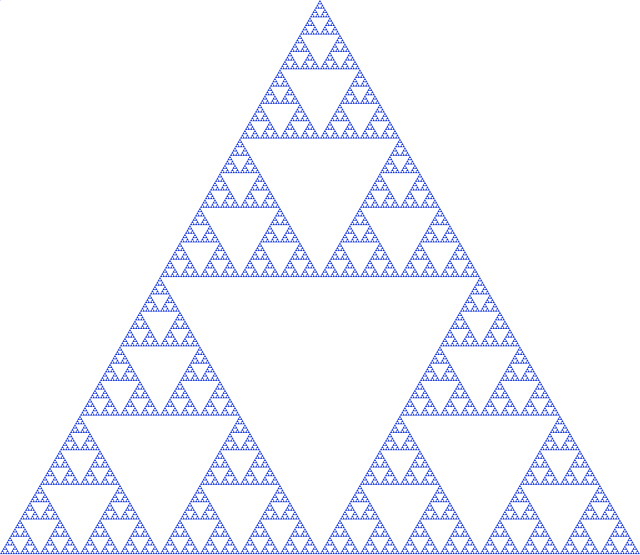Loading AI tools
Fractal composed of triangles From Wikipedia, the free encyclopedia
The Sierpiński triangle, also called the Sierpiński gasket or Sierpiński sieve, is a fractal with the overall shape of an equilateral triangle, subdivided recursively into smaller equilateral triangles. Originally constructed as a curve, this is one of the basic examples of self-similar sets—that is, it is a mathematically generated pattern that is reproducible at any magnification or reduction. It is named after the Polish mathematician Wacław Sierpiński, but appeared as a decorative pattern many centuries before the work of Sierpiński.



There are many different ways of constructing the Sierpiński triangle.
The Sierpiński triangle may be constructed from an equilateral triangle by repeated removal of triangular subsets:

Each removed triangle (a trema) is topologically an open set.[1] This process of recursively removing triangles is an example of a finite subdivision rule.
The same sequence of shapes, converging to the Sierpiński triangle, can alternatively be generated by the following steps:
This infinite process is not dependent upon the starting shape being a triangle—it is just clearer that way. The first few steps starting, for example, from a square also tend towards a Sierpiński triangle. Michael Barnsley used an image of a fish to illustrate this in his paper "V-variable fractals and superfractals."[2][3]

The actual fractal is what would be obtained after an infinite number of iterations. More formally, one describes it in terms of functions on closed sets of points. If we let dA denote the dilation by a factor of 1/2 about a point A, then the Sierpiński triangle with corners A, B, and C is the fixed set of the transformation .
This is an attractive fixed set, so that when the operation is applied to any other set repeatedly, the images converge on the Sierpiński triangle. This is what is happening with the triangle above, but any other set would suffice.

If one takes a point and applies each of the transformations dA, dB, and dC to it randomly, the resulting points will be dense in the Sierpiński triangle, so the following algorithm will again generate arbitrarily close approximations to it:[4]
Start by labeling p1, p2 and p3 as the corners of the Sierpiński triangle, and a random point v1. Set vn+1 = 1/2(vn + prn), where rn is a random number 1, 2 or 3. Draw the points v1 to v∞. If the first point v1 was a point on the Sierpiński triangle, then all the points vn lie on the Sierpiński triangle. If the first point v1 to lie within the perimeter of the triangle is not a point on the Sierpiński triangle, none of the points vn will lie on the Sierpiński triangle, however they will converge on the triangle. If v1 is outside the triangle, the only way vn will land on the actual triangle, is if vn is on what would be part of the triangle, if the triangle was infinitely large.
Or more simply:
This method is also called the chaos game, and is an example of an iterated function system. You can start from any point outside or inside the triangle, and it would eventually form the Sierpiński Gasket with a few leftover points (if the starting point lies on the outline of the triangle, there are no leftover points). With pencil and paper, a brief outline is formed after placing approximately one hundred points, and detail begins to appear after a few hundred.

Another construction for the Sierpiński gasket shows that it can be constructed as a curve in the plane. It is formed by a process of repeated modification of simpler curves, analogous to the construction of the Koch snowflake:
At every iteration, this construction gives a continuous curve. In the limit, these approach a curve that traces out the Sierpiński triangle by a single continuous directed (infinitely wiggly) path, which is called the Sierpiński arrowhead.[5] In fact, the aim of Sierpiński's original article in 1915 was to show an example of a curve (a Cantorian curve), as the title of the article itself declares.[6][7]
The Sierpiński triangle also appears in certain cellular automata (such as Rule 90), including those relating to Conway's Game of Life. For instance, the Life-like cellular automaton B1/S12 when applied to a single cell will generate four approximations of the Sierpiński triangle.[8] A very long, one cell–thick line in standard life will create two mirrored Sierpiński triangles. The time-space diagram of a replicator pattern in a cellular automaton also often resembles a Sierpiński triangle, such as that of the common replicator in HighLife.[9] The Sierpiński triangle can also be found in the Ulam-Warburton automaton and the Hex-Ulam-Warburton automaton.[10]

If one takes Pascal's triangle with rows and colors the even numbers white, and the odd numbers black, the result is an approximation to the Sierpiński triangle. More precisely, the limit as n approaches infinity of this parity-colored -row Pascal triangle is the Sierpiński triangle.[11]
As the proportion of black numbers tends to zero with increasing n, a corollary is that the proportion of odd binomial coefficients tends to zero as n tends to infinity.[12]
The Towers of Hanoi puzzle involves moving disks of different sizes between three pegs, maintaining the property that no disk is ever placed on top of a smaller disk. The states of an n-disk puzzle, and the allowable moves from one state to another, form an undirected graph, the Hanoi graph, that can be represented geometrically as the intersection graph of the set of triangles remaining after the nth step in the construction of the Sierpiński triangle. Thus, in the limit as n goes to infinity, this sequence of graphs can be interpreted as a discrete analogue of the Sierpiński triangle.[13]
For integer number of dimensions , when doubling a side of an object, copies of it are created, i.e. 2 copies for 1-dimensional object, 4 copies for 2-dimensional object and 8 copies for 3-dimensional object. For the Sierpiński triangle, doubling its side creates 3 copies of itself. Thus the Sierpiński triangle has Hausdorff dimension , which follows from solving for .[14]
The area of a Sierpiński triangle is zero (in Lebesgue measure). The area remaining after each iteration is of the area from the previous iteration, and an infinite number of iterations results in an area approaching zero.[15]
The points of a Sierpiński triangle have a simple characterization in barycentric coordinates.[16] If a point has barycentric coordinates , expressed as binary numerals, then the point is in Sierpiński's triangle if and only if for all .
A generalization of the Sierpiński triangle can also be generated using Pascal's triangle if a different modulus is used. Iteration can be generated by taking a Pascal's triangle with rows and coloring numbers by their value modulo . As approaches infinity, a fractal is generated.
The same fractal can be achieved by dividing a triangle into a tessellation of similar triangles and removing the triangles that are upside-down from the original, then iterating this step with each smaller triangle.
Conversely, the fractal can also be generated by beginning with a triangle and duplicating it and arranging of the new figures in the same orientation into a larger similar triangle with the vertices of the previous figures touching, then iterating that step.[17]

The Sierpiński tetrahedron or tetrix is the three-dimensional analogue of the Sierpiński triangle, formed by repeatedly shrinking a regular tetrahedron to one half its original height, putting together four copies of this tetrahedron with corners touching, and then repeating the process.
A tetrix constructed from an initial tetrahedron of side-length has the property that the total surface area remains constant with each iteration. The initial surface area of the (iteration-0) tetrahedron of side-length is . The next iteration consists of four copies with side length , so the total area is again. Subsequent iterations again quadruple the number of copies and halve the side length, preserving the overall area. Meanwhile, the volume of the construction is halved at every step and therefore approaches zero. The limit of this process has neither volume nor surface but, like the Sierpiński gasket, is an intricately connected curve. Its Hausdorff dimension is ; here "log" denotes the natural logarithm, the numerator is the logarithm of the number of copies of the shape formed from each copy of the previous iteration, and the denominator is the logarithm of the factor by which these copies are scaled down from the previous iteration. If all points are projected onto a plane that is parallel to two of the outer edges, they exactly fill a square of side length without overlap.[18]

Wacław Sierpiński described the Sierpiński triangle in 1915. However, similar patterns appear already as a common motif of 13th-century Cosmatesque inlay stonework.[19]
The Apollonian gasket, named for Apollonius of Perga (3rd century BC), was first described by Gottfried Leibniz (17th century) and is a curved precursor of the 20th-century Sierpiński triangle.[20][21][22]
The usage of the word "gasket" to refer to the Sierpiński triangle refers to gaskets such as are found in motors, and which sometimes feature a series of holes of decreasing size, similar to the fractal; this usage was coined by Benoit Mandelbrot, who thought the fractal looked similar to "the part that prevents leaks in motors".[23]
Seamless Wikipedia browsing. On steroids.
Every time you click a link to Wikipedia, Wiktionary or Wikiquote in your browser's search results, it will show the modern Wikiwand interface.
Wikiwand extension is a five stars, simple, with minimum permission required to keep your browsing private, safe and transparent.